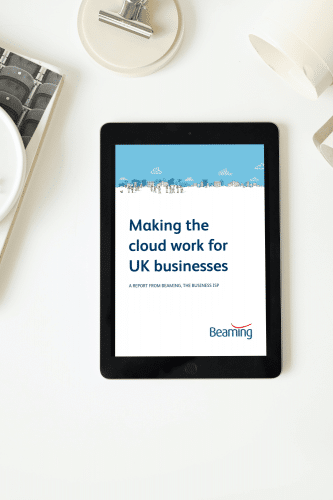5 Steps to Getting SME SaaS Licences Under Control
British SMEs have their heads in the clouds. Well, the Cloud. Earlier this year, we surveyed 500 leaders of small-to-medium-sized companies. We found that cloud computing is now more commonly used than on-premise IT in this part of the business community.
But not everyone’s a winner in this move to the cloud. Over a fifth of the firms surveyed (22%) said the move was ‘bad for business’, while a quarter of all participants (26%) are concerned with the steadily rising costs of cloud services.
Those costs keep climbing. Now, UK SMEs are braced for a 10% rise in cloud computing costs in line with inflation. As more services move to the cloud, firms should be proactive to get maximum value for money.
For some support, Beaming presents five steps to getting SaaS licences under control.
1. Do you know what you’re paying for?
Subscription spending is becoming more decentralised. SaaS platform Zylo, reported that app ownership is moving away from IT teams and towards other business units, which now account for 63% of total enterprise SaaS spend.
A lack of visibility could lead to unnecessary overspend. Look across all teams to understand exactly what cloud data storage platforms and SaaS licences your departments use. They could include:
- Remote working solutions, adopted early in the pandemic, which may no longer be needed. In our survey, 29% of UK SMEs adopted the cloud to support remote working.
- Apps and platforms that offered trials or free usage up to a certain threshold of data storage. These services may no longer be cost-effective.
- Multiple instances of subscriptions in siloed departments. Or multiple applications being used to complete similar tasks.
2. Build a cloud data strategy
Now that you know what you’re paying for, it’s time to plan your SaaS strategy. This process starts with data.
Several questions will affect your decision: How much data do you need to keep? How long do you need to keep it? And does it need to go in the cloud?
In response to rising costs, 47% of small businesses plan to reduce their use of cloud-based services in 2023, and 36% said they would reduce the level of data held in the cloud.
Reducing unnecessary data use will help cut costs and stick to GDPR. For the remainder, look across your options for cloud, on-premise servers and hybrid solutions.
On-premise data centres require upfront capital expenditure, ongoing running costs, and IT support. With cloud, these costs are covered in the licences and operational expenditure.
If you’re unsure of a clear route, get advice on what technology and applications will best meet your needs. An IT partner can identify the best match for your needs and budget.
3. Get everyone in the know
With a strategy in place, the next step is getting buy-in across the board.
If you are paying for a cloud application, ensure all employees know how to use it as well as possible to get the most value.
Issue data storage guidelines that drive consistent best practices across the organisation. That way, you are not paying for data that is not needed, or using applications unnecessarily.
4. Building Accountability
One person in the business should take ownership of these costs. Each department head should be aware of their spending and tasked to ensure standardisation where appropriate.
Cost-centre billing for IT can create a cost-conscious culture and prevent costs from increasing without clear visibility.
5. Keep tabs on your new way of working
Your managed service provider or expert IT partner should be able to support you with accessing regular cloud management reports. These will give you oversight of what you’re storing.
Look out for unused capacity you are paying for and trends towards increasing data storage.
Use regular reports to support future planning, so you have the capacity for growth or operational changes. Preparing in advance can help you use your IT resources in a more considered way.
These are just some ways businesses can measure and manage their SaaS subscriptions. Ultimately, the steps you take should be specific to your setup. An IT partner can help identify the best strategy for your business and put you on cloud nine.
For more support in making the most of your cloud computing, download your free copy of Beaming’s Report: Making the cloud work for UK businesses:
The report contains insights and useful guides, including:
- IT trends in UK businesses – results from our survey of UK business leaders
- 4-step guide: How businesses can reap the full benefits of cloud working
- The cost of cloud: Facts and figures
- What are SMEs doing about the creeping cost of cloud?
- How can businesses get their cloud spending under control?
- 5 step guide: Reviewing your cloud costs
About Beaming
We’re Beaming, a specialist internet service provider (ISP) for businesses. We’ve been helping organisations across the UK with fast, reliable, and secure voice and data connectivity, as well as managed services, since 2004.
From the resilient and secure network we’ve built, to the choice of tailormade products all supplied with expert service, we provide peace of mind that businesses require.
We know that your business is unique, so we take the time to get to know you and your specific needs. If you’re looking for a reliable ISP for your business, we’d love to chat.
